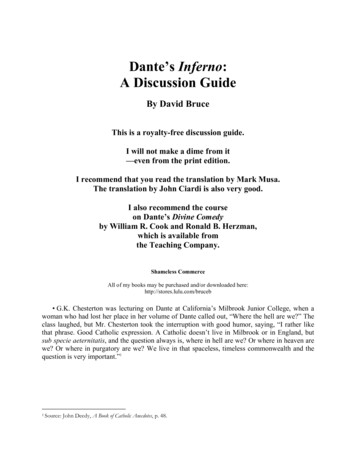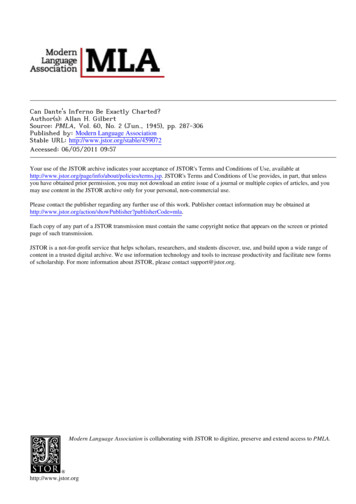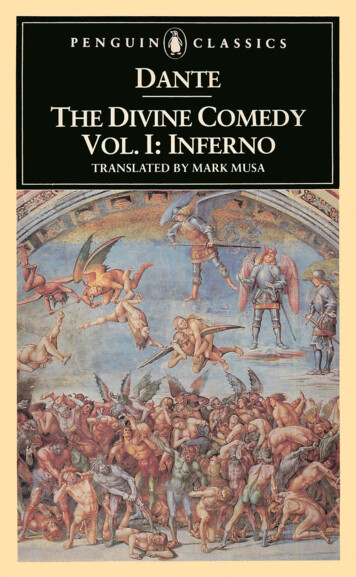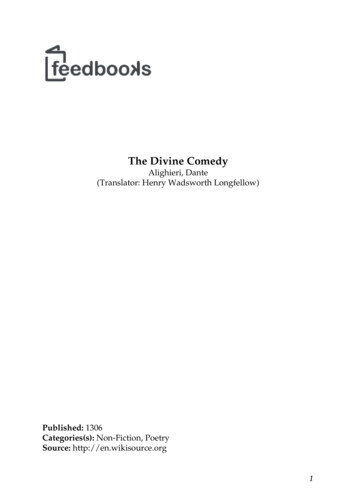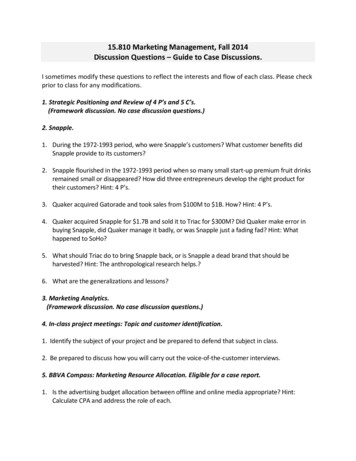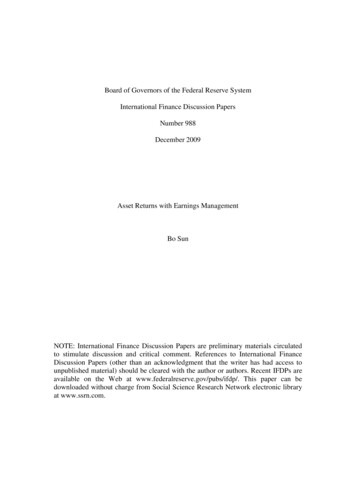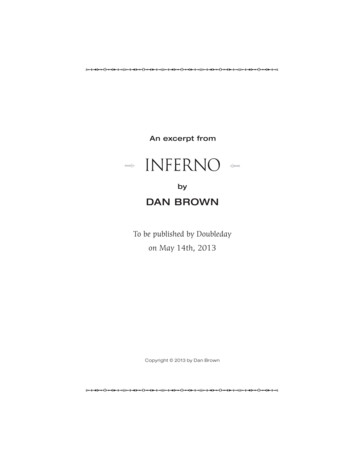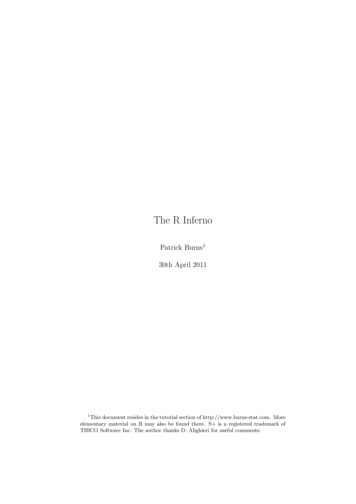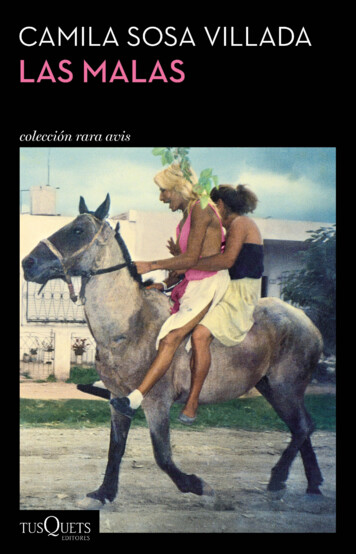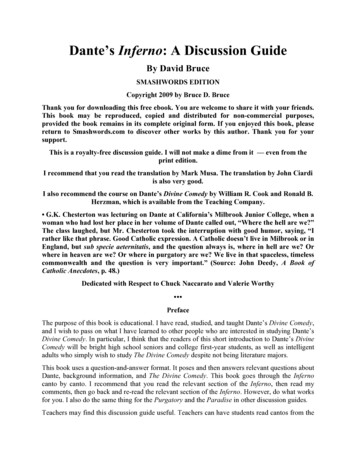
Transcription
Dante’s Inferno: A Discussion GuideBy David BruceSMASHWORDS EDITIONCopyright 2009 by Bruce D. BruceThank you for downloading this free ebook. You are welcome to share it with your friends.This book may be reproduced, copied and distributed for non-commercial purposes,provided the book remains in its complete original form. If you enjoyed this book, pleasereturn to Smashwords.com to discover other works by this author. Thank you for yoursupport.This is a royalty-free discussion guide. I will not make a dime from it — even from theprint edition.I recommend that you read the translation by Mark Musa. The translation by John Ciardiis also very good.I also recommend the course on Dante’s Divine Comedy by William R. Cook and Ronald B.Herzman, which is available from the Teaching Company. G.K. Chesterton was lecturing on Dante at California’s Milbrook Junior College, when awoman who had lost her place in her volume of Dante called out, “Where the hell are we?”The class laughed, but Mr. Chesterton took the interruption with good humor, saying, “Irather like that phrase. Good Catholic expression. A Catholic doesn’t live in Milbrook or inEngland, but sub specie aeternitatis, and the question always is, where in hell are we? Orwhere in heaven are we? Or where in purgatory are we? We live in that spaceless, timelesscommonwealth and the question is very important.” (Source: John Deedy, A Book ofCatholic Anecdotes, p. 48.)Dedicated with Respect to Chuck Naccarato and Valerie Worthy PrefaceThe purpose of this book is educational. I have read, studied, and taught Dante’s Divine Comedy,and I wish to pass on what I have learned to other people who are interested in studying Dante’sDivine Comedy. In particular, I think that the readers of this short introduction to Dante’s DivineComedy will be bright high school seniors and college first-year students, as well as intelligentadults who simply wish to study The Divine Comedy despite not being literature majors.This book uses a question-and-answer format. It poses and then answers relevant questions aboutDante, background information, and The Divine Comedy. This book goes through the Infernocanto by canto. I recommend that you read the relevant section of the Inferno, then read mycomments, then go back and re-read the relevant section of the Inferno. However, do what worksfor you. I also do the same thing for the Purgatory and the Paradise in other discussion guides.Teachers may find this discussion guide useful. Teachers can have students read cantos from the
epic poem, then teachers can ask students selected questions from this discussion guide.It helps to know something about Homer’s Iliad and Odyssey, Virgil’s Aeneid, Greek and Romanmythology, the Bible, Ovid’s Metamorphoses, and other works such as Saint Augustine’sConfessions, but this background reading is not strictly necessary. You have to begin readinggreat literature somewhere, and Dante’s Divine Comedy is a good place to start. (Come on in!The water’s great! And later you can go and read the Iliad, Odyssey, Aeneid, etc.)This book uses many short quotations from Mark Musa’s translation of The Divine Comedy andfrom John Ciardi’s translation of The Divine Comedy. If I don’t identify the translator of apassage as John Ciardi, the translator is Mark Musa. This use is consistent with fair use:§ 107. Limitations on exclusive rights: Fair use Release date: 2004-04-30Notwithstanding the provisions of sections 106 and 106A, the fair use of a copyrighted work,including such use by reproduction in copies or phonorecords or by any other means specified bythat section, for purposes such as criticism, comment, news reporting, teaching (includingmultiple copies for classroom use), scholarship, or research, is not an infringement of copyright.In determining whether the use made of a work in any particular case is a fair use the factors tobe considered shall include —(1) the purpose and character of the use, including whether such use is of a commercial nature oris for nonprofit educational purposes;(2) the nature of the copyrighted work;(3) the amount and substantiality of the portion used in relation to the copyrighted work as awhole; and(4) the effect of the use upon the potential market for or value of the copyrighted work.The fact that a work is unpublished shall not itself bar a finding of fair use if such finding ismade upon consideration of all the above factors.Source of Fair Use information: http://www.law.cornell.edu/uscode/text/17/107 .The long quotations (those in block format) are from the translation by Henry WadsworthLongfellow, unless otherwise noted. This translation is no longer under copyright.Introduction to The Divine Comedy Who was Dante Alighieri?Dante, of course, is the author of The Divine Comedy. He was born a Roman Catholic inFlorence in 1265 C.E. He died of malaria in Ravenna, Italy, in 1321 (the night of Sept. 13-14).He remains buried in Ravenna, although an empty tomb in Florence is dedicated to him. Dante isknown for his ability as a world-class poet, for his interest in politics, and for being exiled fromFlorence. In a way, he remains exiled from Florence, as his body in not in a tomb in Florence. What is The Divine Comedy in essence?The Divine Comedy tells about Dante’s imaginative journey through the afterlife. Dante findshimself in a dark wood of error, and his guide, Virgil, the author of the Roman epic The Aeneid,
takes Dante through the Inferno (Hell), and up the Mountain of Purgatory to the Forest of Eden.There Beatrice, Dante’s beloved who died early in life, takes over as Dante’s guide, and the twoascend the spheres of Paradise, until finally Dante, with the aid of another guide and of theVirgin Mary, is able to see God face to face. These three parts of Dante’s imaginative journeymake up the three parts of The Divine Comedy: the Inferno, the Purgatorio, and the Paradiso.In The Divine Comedy, Dante tells the reader how to achieve Paradise. In addition, the epic is alove story. A woman takes it upon herself to save Dante. How long does the journey in The Divine Comedy take?Considering all the distance that is traveled, it doesn’t take long at all. It begins on the nightbefore Good Friday and ends on Easter Wednesday of the year 1300, when Dante was 35 yearsold (midway through his three score and ten years). The journey takes roughly five and a halfdays. The year 1300 is significant other than being the midpoint of Dante’s life. In 1300, spiritualrepentance and spiritual renewal were major themes of the Catholic Church’s first Holy Year. What is the scope of The Divine Comedy?Herman Melville, author of Moby Dick, once said that in order to write a mighty book, an authorneeds to choose a mighty theme. By choosing the afterlife as his theme, Dante chose a mightytheme. He writes about the Inferno and how sins are punished, about Purgatory and how sins arepurged, and about Paradise and how good souls are rewarded. In doing this, he writes aboutmany themes that are important to the people of his time and to the people of our time and topeople of any time: religion, God, poetry, politics, etc. Is The Divine Comedy universal?“Universal” means applicable to anyone, at any time, and anywhere. Yes, The Divine Comedy isuniversal. One need not be a Christian to enjoy and learn from The Divine Comedy. All of us sin,and probably most of us regret sinning. Many people can identify with the characters of TheDivine Comedy. For example, Francesca da Rimini refuses to take responsibility for her actions,instead casting blame on other people. Many of us have done exactly the same thing.Reading The Divine Comedy seriously will take some work. Readers will need to knowsomething about Dante’s biography, about the history of his time and previous eras, and aboutliterature. However, The Divine Comedy is relevant to our lives today, and this book and itscompanion volumes can be your guide to Dante’s Divine Comedy. What are some of the really big issues that are of concern to The Divine Comedy?One big issue is sin. For example, what are the results of sin?One big issue is spiritual transformation. For example, how can one purge him- or herself of sin?One big issue is politics. For example, Dante warns the reader about the dangers of extremefactionalism.One big issue is poetry. How can poetry help us?Of course, one really big issue is this: How do I enter Paradise? This book is your guide to The Divine Comedy. What is the purpose of a guide?
A guide will help you to cover territory safely the first time you go through the territory.However, many guides, including teachers, want to make themselves irrelevant. By reading thisbook as you read Dante’s Inferno, you will get a good grasp of the material, but I hope that youcontinue to read The Divine Comedy and the Inferno on your own, making it a part of your lifeand going beyond what is written here. The Divine Comedy is one of the Great Books of WesternLiterature — a book that you can reread with interest and profit each year of your life. Briefly, what are the major facts of the biography of Dante the Poet?Dante was born in 1265 in Florence, Italy. He was successful in both poetry and politics. Early,he fell in love with Beatrice, a woman who died young in 1290. Both Dante and Beatrice marriedother people. About Beatrice Dante wrote a group of poems that he published in a volume (withcommentary) titled Vita Nuova (The New Life).Dante was a member of the political group known as the Guelfs, but when the Guelfs split intorival factions, he became a White Guelf. The White Guelfs opposed the Pope and wantedFlorence to be free from papal power, while the Black Guelfs supported the Pope and werewilling to do his bidding if he put them in power. Not surprisingly, Pope Boniface VIII supportedthe Black Guelfs, and he sent troops to Florence who took over the city in November of 1301.We can date Dante’s exile from Florence at this time, but he was officially exiled in January of1302. Dante never returned to Florence.While in exile, Dante composed his masterpiece: The Divine Comedy. He died on Ravenna in1321 at age 56.By the way, “Guelf” is sometimes spelled “Guelph.” The Italian word can be transliterated intoEnglish in these two ways. What does the title The Divine Comedy mean?Dante called his poem the Commedia or Comedy. In the 16th century, the word Divina or Divinewas added to the title to show that it was a work rooted in religion.The Divine Comedy is a “comedy” for two reasons:1) The Divine Comedy was not written in Latin, but was instead written in the “vulgar”language of Italian. Being written in a “vulgar” language, the vernacular, it is written in alanguage that was regarded as not suited for tragedy.2) The epic poem has a happy ending. What is the difference between Dante the Pilgrim and Dante the Poet?Dante the Pilgrim is different from Dante the Poet. Dante the Pilgrim is a character in The DivineComedy. At the beginning, he is naive and sometimes believes the spin that the sinners in theInferno put on their own stories. However, Dante the Poet is an older, wiser Dante. Dante thePoet has journeyed throughout the Inferno, Purgatory, and Paradise, and he sees through thestories that the sinners tell in the Inferno.Dante the Poet is the author of The Divine Comedy, whose major character is Dante the Pilgrim.Dante the Poet has more knowledge and experience than Dante the Pilgrim.
For example, Dante the Poet knows that he has been exiled from Florence because he is in exilewhen he writes The Divine Comedy. Because the poem is set in 1300, and Dante is not officiallyexiled until 1302, Dante the Pilgrim does not know at the beginning of the poem that he will beexiled. He will hear the prophecies of his upcoming exile that are made in the Inferno, but he willnot fully understand that he will be exiled until his ancestor Cacciaguida clearly tells him that inthe Paradise.Dante the Poet is also more intelligent than Dante the Pilgrim. Dante the Pilgrim will sometimesbe taken in by the spin that sinners in the Inferno put on their stories, but Dante the Poet knowsthat God does not make mistakes. If a sinner is in the Inferno, Dante the Poet knows that thesinner belongs there. The Divine Comedy is an allegory. Define “allegory.”An allegory has a double meaning. It can be understood on a literal level, but also present is asymbolic level. On the literal level, Dante the Pilgrim travels through the Inferno, Purgatory, andParadise. On the symbolic level, a human soul who will be saved faces trials, overcomes them,and achieves Paradise.Allegories have many symbols. What do you need to be in the Afterlife in Dante’s Inferno?You must meet three criteria:1) You must be dead.2) You must be dead in 1300 (with a few exceptions where a soul is in the Inferno whilea demon occupies the soul’s body in the living world).3) You must be an unrepentant sinner. (After all, if you are a dead repentant sinner, youwould be found in either Purgatory or Paradise.) What does it mean to repent?To repent your sins means to regret them. Of course, this does not mean regretting being caughtfor doing them, but regretting the sins themselves.The sinners Dante will meet in the Inferno are unrepentant sinners. The repentant sinners he willmeet in Purgatory treat Dante very much differently from the way the unrepentant sinners hemeets in the Inferno treat him. What is the geography of Hell? In The Divine Comedy, where is Hell located?Dante did not think that the world was flat. (Educated people of his time did not think the worldwas flat.) To get to the Inferno, you go down. The story is that Lucifer rebelled against God, wasthrown from Paradise to the Earth, and landed on the point of the earth that is opposite toJerusalem. His landing made the Southern Hemisphere composed of water as the land rushedunder the water to hide from him. In addition, when he fell to the center of the Earth the land hedisplaced formed the Mountain of Purgatory.Dante and Virgil will climb down to the center of the Earth, where Lucifer is punished, then theywill keep climbing up to the other side of the world, where they will climb Mount Purgatory.
Explain the three separate kinds of moral failure: incontinence, violence, and fraud.IncontinenceIncontinence is not being able to control yourself. For example, you may not be able to controlyour sexual desire (lust) or your desire for food and drink (gluttony).ViolenceViolence can be directed against yourself (suicide), against God (blasphemy), or against otherpeople (physical violence).FraudFraud involves the willful use of misrepresentation to deprive another person of his or her rights.For example, one can claim to be able to foretell the future and charge people money to tell themtheir “future.”Complex fraud is fraud committed against those to whom one has a special obligation of trust.Sinners who commit complex fraud are traitors of various kinds: e.g., traitors to kin/family,traitors to government, traitors to guests, or traitors to God.Simple fraud is fraud, but it is not committed against those to whom one has a special obligationof trust.Of course, sin is the opposite of virtue, and we can look at these kinds of sins as being theopposite of kinds of virtues.Incontinence is the opposite of moderation.Violence is the opposite of courage.Fraud is the opposite of wisdom.Another classical virtue is Justice, and we will see an unjust city in the Inferno. What kinds of characters will we see in The Divine Comedy?We will see both real characters and fictional characters. Mythological creatures will often be theguards in the Inferno.Some of the characters will be important historically and globally, while others will be importantonly locally and would in fact be forgotten if they had not been mentioned in the Inferno. What do the sinners in the Inferno all have in common? Why can’t we take what thesinners say at face value?They have in common the fact that they are unrepentant. They do not take responsibility for thesins they have committed. Because of that, they will spin their stories and try to put the blame onsomeone or something else.When we read the Inferno, we must be careful to try to see the whole story. The sinners will nottell the truth, the whole truth, and nothing but the truth. (Reading this discussion guide to Dante’sInferno or the notes in the translation of the Inferno that you are reading can help you to
understand when a character is trying to spin you.)Be aware that many people in the Inferno are going to be able to tell a good story, and you mayend up thinking — like Dante the Pilgrim sometimes — that a certain sinner does not belong inHell. However, Dante the Poet realizes that God doesn’t make mistakes. Anyone who is in Helldeserves to be in Hell. It’s important to closely examine the stories of some persuasive sinners tosee what they are leaving out. Why do people sin?Two main reasons, perhaps:1) A lack of will. Often, we know that what we ought to do, but we can’t bring ourselvesto do it. (Everyone who needs to lose 10 pounds knows exactly what to do to lose it:Exercise more and eat less. A student who exercises less than needed and eats more thanneeded without a good reason such as illness is guilty of the sin of gluttony.)2) An attractive veneer. Sometimes, sinning can appear to be attractive and to be fun, andthus people are tempted to sin. (Staying up late, getting drunk, and partying can be fun,but if these things prevent a student from attending class, that student is guilty of the sinof sloth.) Does God make mistakes? Do these sinners belong in the Inferno?We must be careful when reading the Inferno. Dante the Pilgrim will sympathize with somesinners early in the Inferno, and we may be tempted to do exactly the same thing, but God isomniscient, omnipotent, and omnibenevolent. God does not make mistakes. If a sinner is in theInferno, the sinner belongs there.By the way, the difference between Inferno and Inferno is that Inferno is the title of a book andInferno is the name of a place. (Similarly, Hamlet is the title of a play, and Hamlet is the name ofa character in that play.)InfernoChapter 1: “Canto 1: The Dark Wood of Error” What is the time in which Canto 1 is set?The time is just before Good Friday, 8 April 1300. Explain the first 12 lines of the Inferno. What does Dante say in these lines?We learn these things:1) Dante the Pilgrim is 35 years old. He is “Midway along the journey of our life” (Musa InfernoI.1). The Biblical three score and ten years of an average human lifespan is 70 years, so thehalfway point is 35 years.By the way, (Inferno 1.1) means that the line being quoted is line 1 of Canto 1 of the Inferno. Iwill be using Mark Musa’s translation of the Inferno and John Ciardi’s translation of the Infernoin this book. Remember: If I don’t identify the translator of a passage as John Ciardi, thetranslator is Mark Musa. The long quotations (those in block format) will mainly be from the
translation by Henry Wadsworth Longfellow, unless otherwise noted.2) We learn that Dante the Pilgrim is “in a dark wood” (Musa Inferno 1.2), that he has“wandered off from the straight path” (Musa Inferno 1.3), and that he has strayed from “the pathof truth” (Musa Inferno 1.12). Write a character analysis of Dante the Pilgrim as he appears at the beginning of theInferno.Dante the Pilgrim in Canto 1 of the Inferno is a sinner in trouble. He is disoriented, and he needshelp to get himself out of the “dark wood” (Musa Inferno 1.1) of error. Fortunately, he will getthe help he needs.We aren’t told how Dante gets into the dark wood, but many people get there little by little. Itisn’t that they commit some great evil, but that one day they wake up and think, How did I gethere? Why am I this kind of person? I didn’t mean to be here.Sex workers sometimes wonder how they ended up in that profession. Probably very few peoplemake being a sex worker their career of choice. Dante attempts to climb up the hill to the light, but three beasts keep him from reachingthe light. Allegorically, what does this mean?Dante the Pilgrim wants to get out of the dark wood, of course, and he attempts to climb to thesun. Because The Divine Comedy is an allegory, Dante makes the sun a symbol. Here it can be asymbol of God and of truth and of salvation.Much critical ink has been spilled interpreting the symbols of the three beasts: the leopard, thelion, and the wolf. In general, we can say that the three beasts represent sins. They may representthe sins of youth, of middle age, and of old age. On the other hand, they may represent the sinsthat make up the three major classifications of the Inferno: incontinence, violence, and fraud. Orthey can represent lust, pride, and cupidity. What seems certain is that these three animalssymbolize sin.The three animals are taken from Jeremiah 5:6. This is the King James version:6: Wherefore a lion out of the forest shall slay them, and a wolf of the evenings shallspoil them, a leopard shall watch over their cities: every one that goeth out thence shallbe torn in pieces: because their transgressions are many, and their backslidings areincreased. Dante tries to reach the light by himself, but he fails. He needs a guide. Dante thePilgrim’s first guide is Virgil. Who is Virgil?Virgil, of course, is the author of the Aeneid. He is a writing hero for Dante, who praises himhighly and says that he learned about poetic style from him:“Thou art my master, and my author thou,Thou art alone the one from whom I tookThe beautiful style that has done honor to me.”
(Longfellow 1.85-87)Virgil is also on a mission from God, by way of a mission from Beatrice. Virgil has been sent toguide Dante out of the dark wood and to another guide who can take him further than Virgil can.Virgil is a symbol of human reason, which is powerful, but which Dante regarded as lesspowerful than faith. Dante’s next guide, Beatrice, who represents faith, will take Dante furtheralong on his journey than Virgil (human reason) can. Dante is aware that Virgil, as a pagan, doesnot know God:And I to him: “Poet, I thee entreat,By that same God whom thou didst never know,So that I may escape this woe and worse,”(Longfellow 1.130-132)Dante, as you would expect, thinks that it is wonderful that his hero, Virgil, is his guide.Although hesitant out of fear, he eventually agrees to go wherever Virgil will lead him. Virgil outlines the three-part journey facing Dante. What are those three parts?The three parts of the journey are these:1) The Inferno, where many souls shriek.2) Purgatory, where souls willingly undergo a purifying fire.3) Paradise, where the everlastingly blessed dwell. Canto 1 actually introduces the entire Divine Comedy.The Divine Comedy is comprised of 100 cantos or songs. The first canto is an introduction to theentire Divine Comedy, so we may want to say that the Inferno has 33 cantos, as do the Purgatoryand the Paradise.Numbers are important to Dante. We know of course that three is an important number becauseit is the number of the Trinity: God the Father, Son, and Holy Ghost. We see the number threethroughout The Divine Comedy; for example, Dante writes tercets: stanzas of three lines.The number ten is another important number. Ten consists of three Trinities plus one Unity. Whydoes Dante have 100 cantos in his Divine Comedy? The number 100 consists of ten times ten.Chapter 2: “Canto 2: Dante Hesitates” Dante must endure a journey that he likens to a battle. Why does he make thatcomparison?Dante writes that “I, one man alone, / was making ready to endure the battle / of the journey, andof the pity it involved” (Musa Inferno 2.3-5).Of course, the journey through the Inferno is difficult, so it can be likened to a battle. In addition,Dante must be on his guard against pitying the sinners, many of whom will attempt to gain hispity by telling him only part of their stories and leaving out whatever makes the sinner look bad.
Dante the Pilgrim is still naïve at this point; he needs to learn that God does not make mistakesand that the sinners in the Inferno deserve their punishment. Dante the Poet makes an invocation to the Muses. What is an invocation, and who are theMuses?The Muses are ancient goddesses of the arts.In an invocation, a poet asks the Muses for help in singing a song (such as an epic poem). BothVirgil and Homer invoked the Muses in telling their epic poems.This is how Dante invokes the Muses:O Muses, O high genius, now assist me!O memory, that didst write down what I saw,Here thy nobility shall be manifest!(Longfellow 2.7-9) In Canto 2, why does Dante have second thoughts about allowing Virgil to be his guide?One thing to notice is that Dante has second thoughts here, although eventually, of course, hedecides to allow Virgil to be his guide.We can be sympathetic here. The Inferno is a place where many souls shriek with despair. Thisis not going to be a pleasant visit to a tourist destination. In fact, at one point later in the Inferno(Canto 11), Dante and Virgil have to rest to allow themselves to become accustomed to thestench that is rising from the lower Circles of the Inferno.Another thing to notice is that Dante gets help from the outside. God is concerned about Dante,and God allows Virgil and others to guide Dante to salvation. Dante the Pilgrim wonders whether his trip to the Inferno will be successful, althoughboth Aeneas and Saint Paul have successfully made trips to the Inferno (Underworld orHell). Who are Aeneas and Saint Paul, and what were the trips to the Inferno that Dantethe Pilgrim is speaking of?In Canto 2, Dante the Pilgrim mentions a couple of people who have visited the afterlife —people who are (he says) much more worthy than he of the visit.AeneasOne is Aeneas, the hero of Virgil’s Aeneid. Virgil, of course, is Dante’s guide throughout theInferno and most of Purgatory. In Book 6 of the Aeneid, Aeneas visits the underworld in order tolearn more about his destiny — his deceased father, Anchises, shows him his future descendants,who are Roman heroes. Virgil is a good guide through the Inferno; after all, he has been therebefore, imaginatively, while writing his Aeneid.St. PaulThe other major visitor to the afterlife is Saint Paul, who supposedly visited the realms of thedead, a journey described in a medieval work titled Visio Sancti Pauli.
Other HeroesMany ancient heroes visited the underworld, as described in Greek and Roman mythology. Theyinclude Orpheus, Theseus, Hercules, and Odysseus (whose Roman name is Ulysses). See below(Canto 3). Explain who are the three heavenly women who are concerned about Dante.The three heavenly women are these:1) Mary, the mother of Christ. People of the Middle Ages regarded Mary as their spiritualmother.2) Saint Lucia, a 3rd-century martyr. Saint Lucia was the patroness of good eyesight.After Beatrice died, Dante strained his eyes with too much crying (according to his bookthe Vita Nuova). Lucia was an early Christian who was persecuted for being a Christian.She was tortured, including being blinded, and eventually killed by being stabbed with adagger. Note: Her name is pronounced with three syllables, with the stress on the secondsyllable.3) Beatrice. Dante was in love with Beatrice, although they married other people. Shedied young, and Dante mourned her greatly. Why is Virgil Dante’s guide?Dante has three heavenly women looking after him. Beatrice came to Virgil in Limbo to ask himto be Dante’s guide. Beatrice has heard about Dante’s troubles from Saint Lucia, who in turn hadheard about them from Mary. Virgil is very willing to do Beatrice a favor.Virgil makes the persuasive point that with three such heavenly women looking after him, Danteshould not be afraid to go down into the Inferno. Doing that is a necessary part of his journey.We can also give a few other reasons why Virgil ought to be Dante’s guide through the Inferno: In Book 6 of Virgil’s Aeneid, Aeneas makes a trip to the Underworld. Therefore, Virgil isfamiliar with the Inferno. We will find out in Canto 9 that earlier Virgil journeyed as a soul through the Inferno. Thesorceress Erichtho sent him to the bottom of the Inferno to find and bring a soul to her. Onceagain, Virgil is familiar with the territory. In the Middle Ages, Christians believed that Virgil forecast the birth of Christ in his FourthEclogue. Historians believe that Virgil was actually writing about the birth of a Roman.Chapter 3: “Canto 3: The Gate of Hell” At the beginning of Canto 3, we enter Hell.In Canto 3, Dante and Virgil go through the gate that leads into the Inferno. Many ancient heroes have visited the Underworld. Name a few, and briefly describe someof their visits to the Underworld.Theseus was held captive in a chair of forgetfulness in Hades. Hercules rescued him.
Hercules entered the Underworld as part of his labors. He stole Cerberus, the three-headed dog,and took him up into the living world.Odysseus entered the Underworld to get information about his journey home from Troy from theprophet Tiresias.Aeneas visited his father in the Underworld in Book 6 of the Aeneid. What is the meaning of the sign over the entrance to Hell, and who created the sign?The sign over the gate of Hell reads:“Through me the way into the suffering city,Through me the way to the eternal pain,Through me the way that runs among the lost.Justice urged on my high artificer;My maker was divine authority,The highest wisdom, and the primal love.Before me nothing but eternal things were made,And I endure eternally.Abandon every hope, ye who enter here.”(Longfellow 3.1-9)God, of course, created the sign. God is known for being omnipotent (the Father), for the highestwisdom (the Son) and for primal love (the Holy Spirit). We learn that although the Inferno is aplace of eternal damnation, it is also a place of justice. The people who enter
takes Dante through the Inferno (Hell), and up the Mountain of Purgatory to the Forest of Eden. There Beatrice, Dante’s beloved who died early in life, takes over as Dante’s guide, and the two ascend the spheres of Paradise, until finally Dante, with the aid of another guide
